신생아 선천성 귀 기형, Congenital ear malformation of newborn infants
| 선천성 귀 기형의 종류 |
1. 소이증-귓바퀴가 비정상적으로 작은 선천성 귀 기형
2. 대이증-귓바퀴가 비정상적으로 큰 선천성 귀 기형
3. 무이증-귓바퀴가 없는 선천성 귀 기형.
4. 대이-외이도 입구 바로 앞 부위, 이주 바로 앞 부위에 쌀알 크기만 한 피부 주머니, 또는 콩알 크기만 한 피부 주머니. (사진2 참조)
5. 이루공-외이도 입구의 바로 앞 부위(이주 바로 앞 부위)에 있는 안면 피부에 바늘구멍 크기만 한 구멍이 선천적으로 뚫려 있는 귀 기형(사진 28, 29 참조).
6. 부이-외이도 입구의 바로 앞 부위(이주 바로 앞 부위)에 있는 안면 피부에 두드러진 피부돌기가 선천적으로 나 있는 귀 기형(사진 22~27 참조).-부이는 선천성 귀 기형 중 가장 흔한 귀 기형이다.
7. 선천성 무 귀- 외이도와 중이 등이 선천적으로 없는 귀 기형.
8. 돌출 귓바퀴 사진 18 참조.
9. 불완전 이륜 사진 19 참조.
10. 늘어진 귓바퀴 사진 20 참조.
11. 이륜(귓바퀴)에 있는 달윈 돌기. 사진 21 참조.
| 선천성 귀 기형의 치료 및 합병증 |
- 대이가 박테리아에 감염되면 대이가 곪을 수 있다.
- 적절한 항생제로 치료해야 한다. 대이가 자주 곪으면 대이를 수술로 제거 치료해 주기도 한다.
- 대이가 곪지도 않고 미관상 큰 문제가 되지 않으면 그대로 두고 관찰 치료를 한다.
- 이루공도 특별히 치료해 줄 것 없이 그대로 두고 보는 것이 보통이다. 때로는 감염될 수 있다.
- 부이가 가늘고 길쭉하게 생겼을 때는 부이 맨 밑 부분을 실로 꼭 매어 부이를 떼 낼 수 있다(사진 23 참조).
- 사진 23에서 볼 수 있는 것과 같이 피부에 가늘게 붙어 있는 부이 맨 밑 부분을 실로 꼭 잡아맨 후 1~2주 되면 부이가 괴사되고 그 부이 뿌리가 피부에서 자연적으로 떨어지는 것이 보통이다. 그렇지 않으면 수술로 절제하여 떼 낼 수 있다.
- 외이나 외이도, 또는 중이가 태어날 때부터 없으면 외이나 외이도를 성형수술로 새로 만들어 줄 수 있다.
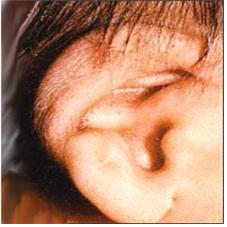
사진 18. 돌출 귓바퀴
출처; Used with permission from Mead Johnson Nutrituional Division과 소아가정간호백과
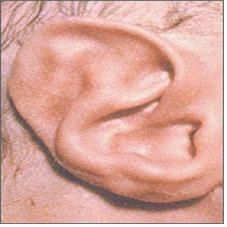
사진 19. 불완전하게 생긴 이개(귓바퀴)
출처; Used with permission from Mead Johnson Nutrituional Division과 소아가정간호백과
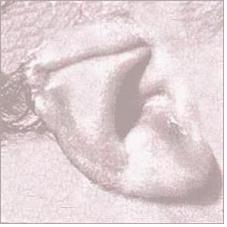
사진 20. 늘어진 귓바퀴
출처; Used with permission from Mead Johnson Nutrituional Division과 소아가정간호백과
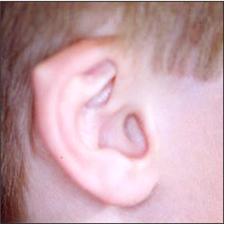
사진 21. 이륜(귓바퀴)에 있는 달윈 돌기
Copyright ⓒ 2011 John Sangwon Lee, M.D.. FAAP
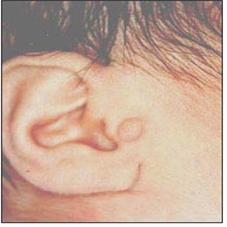
사진 22. 외이도 앞 부위에 난 부이
Copyright ⓒ 2011 John Sangwon Lee, M.D.. FAAP
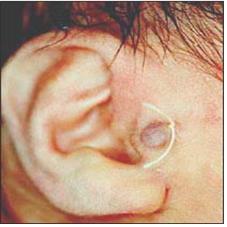
사진 23. 부이의 맨 밑 부분을 실로 꼭 매어 2주 지나면 부이가 괴사된 후 떨어질 수 있다.
Copyright ⓒ 2011 John Sangwon Lee, M.D., FAAP
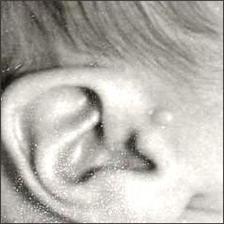
사진 24. 외이도 앞 부위에 난 부이
Copyright ⓒ 2011 John Sangwon Lee, M.D., FAAP
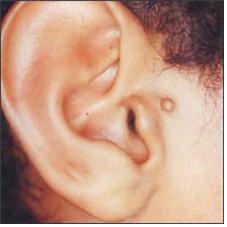
사진 25. 외이도 앞 부위에 난 부이
Copyright ⓒ 2011 John Sangwon Lee, M.D., FAAP
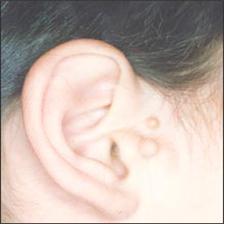
사진 27. 외이도 앞 부위에 난 두 개의 부이
Copyright ⓒ 2011 John Sangwon Lee, M.D., FAAP
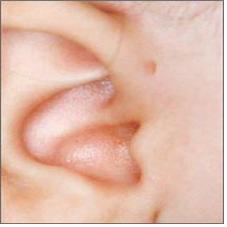
사진 28. 외이도 앞 부위에 난 이루공.
Copyright ⓒ 2011 John Sangwon Lee, M.D., FAAP
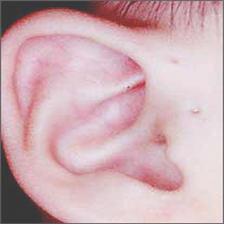
사진 29. 외이도 앞 부위에 난 두 개의 이루공
Copyright ⓒ 2011 John Sangwon Lee, M.D., FAAP
|
다음은 “이루공–귀”에 관한 인터넷 소아청소년 건강 상담 질의응답의 예 입니다. |
Q&A. 이루공– 귀에
Q.
안녕하세요..수고하십니다. 다름이 아니구요. 우리애가가요..지금백일이지나 5일째 구요, 남자아기구요..몸무게7.7kg이구요..그런데..38주에 제왕절개로 태어낫습니다..만삭 때 낳으려고 했는데. 윤달이 있어..앞당겨서 낳았습니다.. 의사선생님께서는 38주 정도면 괜찮다고 해서 출산을 했는데요 잔병치레가 너무 많아요..후회가 되어..늘 애기한테 죄책감을 느껴요…다른 게아니구요..
귀에요..양쪽 다요…구멍이 있어요..얼굴 볼쪽으로요…그게 태어나면서 가지고 나오는 거라고 하던데요.. 평생 그런 건가요? 그리고 그 부분에요..물 같은 게 나와요…심하면 수술해야 한다고 하는데요…저,, 너무 걱정이 되어 잠이 안 오거든요..다른 애들은 안 그런거 같은데..울고 싶어요..귀..구멍에 대해 설명 좀 해주세요…
A.
명자님
안녕하세요. 질문해 주셔 감사합니다.
나이, 성별, 과거, 현재, 가족의 병력, 진찰소견, 임상검사 결과 등 많은 정보가 있으면 더 좋은 답변을 드릴 수 있습니다. 주신 정보를 토대로 답변을 드립니다.
외이도 입구의 바로 앞 안면 피부에 바늘구멍만 한 구멍이 선천적으로 뚫려 있는 귀 기형을 이루공(사진 28, 29 참조)이라고 합니다.
이루공을 말씀하시는 것 같습니다.
거기에 염증이 생긴 것 같습니다.
아기엄마께서도 자상하고 아기에 대한 사랑을 많이 하시는 것 같습니다.
어떤 아이들은 키가 더 크고 어떤 아이들은 키가 더 작고 한쪽 팔이 없이 태어나기도 하고 심장 기형도 가지고 태어나기도 합니다.
이루공도 하나의 선천성 기형의 일종이지만 아주 미미한 선천성 기형 중 하나입니다.
엄마의 잘못으로 그런 기형이 생기는 것은 절대 아닙니다.
쉽게 치료 되니 걱정하시지 말고 적절히 치료를 해 주시면 될 것입니다.
소아청소년과에서 진찰 진단을 받으시고 그 문제에 관해 상담하시기 바랍니다.
귀에 생긴 여러 가지 기형–이루공 등을 참조하시기 바랍니다.
질문이 더 있으면 또 방문하세요. 감사합니다. 이상원 드림
|
다음은 “이루공 유전”에 관한 인터넷 소아청소년 건강상담 질의응답의 예 입니다. |
Q&A 이루공 유전
Q.
안녕하세요..
먼저 질문에 대한 답변 감사드리구요, 한 가지 추가로 여쭤볼께요..
귀기형(외이도 앞쪽에 난 하나의 이루공)은 유전이라고 하셨는데 아기 아빠랑 저는 둘 다 없는데 어떻게 아기한테 생길 수 있는 거죠?
A.
정님
안녕하세요. 질문해 주셔서 감사합니다. 좋은 질문입니다.
자녀의 나이 , 성별, 과거 병력, 가족 병력, 진찰소견, 임상검사 등의 정보를 많이 알수록 답변을 드리는데 도움이 됩니다. 주신 정보를 토대로 해서 답변을 드리겠습니다.
유전 인자로 유전됩니다.
혈우병과 같은 유전성 질환은 성염색체로 유전 되고 그 외 많은 다른 유전성 질환들은 상염색체로 유전되기도 합니다.
유전에는 우성으로 유전되기도 하고 열성으로 유전되기도 합니다.
상염색체로 유전되는 경우는 남아들이나 여아들에게 다 같은 빈도로 유전될 가능성이 있습니다.
유전학에서 표현율(Penetrance rate)이라는 말이 있다. 그 말은 유전병이 나타날 수 있는 빈도를 말합니다.
많은 유전성 질환이 불완전한 표현율로 나타나는 경우가 있습니다.
저는 유전학을 전문하지 안했습니다.
아기의 기형은 열성 표현 상염색체로 생긴 것 같습니다.
유전학 전문의나 소아청소년과 전문의 또는 이비인후과 전문의에게 문의하시는 것이 어떨까요.
도서관이나 서점에서 유전학 참고서를 참고하시는 것도 좋을 것입니다.
소아청소년과 청소년에서 진단 받으시고 이런 문제에 관해서 상담하시기 바랍니다.
질문이 더 있으면 다시 연락해 주시기 바랍니다.
감사합니다. 이상원 드림
|
다음은 “귀에요… 부이”에 관한 인터넷 소아청소년 건강상담 질의응답의 예 입니다. |
Q&A. 귀에요… 부이
Q.
늦었지만 새해 복 많이 받으세요. *^^*
아이가 태어난 지 40여일 정도 되는데요.
태어나면서부터 귀 쪽에 이상한 것이 있어 궁금했는데 이곳 사이트에 들어와서 궁금증을 해소 했네요.
“부이” 인 것 같거든요. 실로 묶어 두면 해결할 수 있다고 하셨는데요.
너무 어리지 않을까 해서요. 지금 해 주는 것이 좋을지 아니면 조금 더 자란 다음에 해 주는 것이 좋을지 시기를 알 수가 없어서 문의 드려요.
첫아이 때에는 그런 것이 없어서 몰랐는데 처음엔 너무 당황하고 속상해서 어떻게 해야 할지를 몰랐어요. 자세히 알려 주시면 감사하겠습니다.
A.
정원님
안녕하세요. 질문해 주셔서 감사합니다. 좋은 질문입니다.
자녀의 나이 , 성별, 과거 병력, 가족 병력, 진찰소견, 임상검사 등의 정보를 많이 알수록 답변을 드리는데 도움이 됩니다. 주신 정보를 토대로 해서 답변을 드리겠습니다.
부이의 크기, 수, 폭, 피부층에 접한 부이 뿌리의 크기, 자녀의 나이 등에 따라 치료를 다르게 할 수 있습니다.
어떤 부이는 상당히 크기 때문에 간단한 수술로 동네 소아청소년과에서 치료할 수 없습니다. 제가 실로 매어 치료한 부이 기형의 경우, 출생 후 바로 병원 신생아실에서 실로 매어 치료한 예입니다.
일반적으로 유치원에 들어갈 때쯤 부모도 자녀도 수술해 부이를 떼어 내고 싶으면 이비인후과에서 수술 치료를 받을 수 있습니다.
그 전에도 수술 치료를 받을 수 있지만 병원에 입원해야 할 경우도 있고 수술로 인한 세균 감염과 그로 인한 감염병이 생길 가능성이 더 있다는 것을 참작해서 좀 더 큰 후 수술 치료받는 것이 일반적입니다.
이 정도로 조그마한 선천성 기형은 생명에도 위험성이 없고 어떤 때는 이 기형으로 더 예쁘게 보일 수도 있고 그 아이 자신이 그것에 대해서 무관심하지만 부모들이 그것에 신경을 더 많이 쓰는 경우가 있습니다.
완전히 치료 받을 때까지 머리카락으로 부이 있는 그쪽을 가릴 수 있게 머리 손질을 적절히 해 주면 그런 귀 기형이 남들에게 잘 보이지 않을 수 있습니다.
소아청소년과에서 진찰 진단을 받으시고 이 문제에 대해서 상담하시기 바랍니다.
질문이 더 있으시면 다시 연락 주시기 바랍니다. 감사합니다. 이상원 드림
Congenital ear malformation of newborn infants 신생아 선천성 귀 기형
Types of congenital ear malformations
1. Congenital smaller ear- malformations with abnormally smaller auricles
2. Greater Congenital ear malformations with abnormally larger auricles
3. No congenital ear malformations without auricles
4. A skin bag the size of a rice grain, or a skin bag the size of a bean. (See photo 2)
5. An ear deformity in which a hole the size of a needle hole is congenital in the skin of the face in the area just in front of the entrance of the ear canal (see photos 28 and 29).
6. Ear deformity with congenital protrusions prominent on the facial skin in the area just in front of the entrance of the ear canal (the area just in front of the migration) (see photos 22-27). They are the most common congenital ear anomalies.
7. Congenitally no ear -Ear deformities without external ear and middle ear.
8. Protruding auricle, See photo 18.
9. incomplete two-auricle,See photo 19.
10. lowering two-auricle, See photo 20.
11. Darwin protrusion on the two rings (auricle). See photo 21.
Treatment and complications of congenital ear malformations
- If the great ear may be infected with the bacteria,
- It should be treated with appropriate antibiotics.
- If the greater ear is infected frequently, the greater ear can be corrected and treated with surgery.
- If the greater ear does not get infection and does not become a big problem in terms of aesthetics, leave it as it is and conduct observational treatment. It is common to leave it as it is, without any special treatment for it.
- Sometimes it can be infected. If the accessory ear is thin and elongated, you can remove the accessory ear by tying the bottom of the accessory ear tightly with a thread (see photo 23).
- As shown in Photo 23, after holding the bottom of the accessory ear thinly attached to the skin with a thread, it is common for the accessory ear to die and the root of the buoy naturally falls from the skin in 1 to 2 weeks.
- Otherwise, it can be surgically excised and removed. If the external ear canal or the middle ear is not present from birth, a new external ear canal can be made with plastic surgery.

Picture 18. Protruding pinna source; Used with permission from Mead Johnson Nutritional Division and Pediatric Family Nursing Encyclopedia

Photo 19. Imperfectly shaped ear canal source; Used with permission from Mead Johnson Nutritional Division and Pediatric Family Nursing Encyclopedia Picture 20. Saggy pinna source; Used with permission from Mead Johnson Nutritional Division and Pediatric Family Nursing Encyclopedia

Picture 21. Darwin’s protuberance on the two-wheel (auricle). Copyright ⓒ 2011 John Sangwon Lee, M.D., FAAP

Picture 22. An accessory ear in front of the ear canal. Copyright ⓒ 2011 John Sangwon Lee, M.D. FAAP

Photo 23. Tie the bottom part of the accessory ear tightly with thread and after 2 weeks, the accessory ear may fall after necrosis. Copyright ⓒ 2011 John Sangwon Lee, M.D., FAAP

Photo 24. Accessory auricle(the accessory ear) in front of the ear canal. Copyright ⓒ 2011 John Sangwon Lee, M.D., FAAP

Picture 25. A accessory auricle in front of the ear canal. Copyright ⓒ 2011 John Sangwon Lee, M.D., FAAP

Picture 27. Two accessory ears in front of the ear cana.l Copyright ⓒ 2011 John Sangwon Lee, M.D., FAAPthe accessory ear

Photo 28.Congenital preauricular sinus in front of the ear canal. Copyright ⓒ 2011 John Sangwon Lee, M.D., FAAP

Photo 29. Two congenital preauricular sinuses in front of the ear canal. Copyright ⓒ 2011 John Sangwon Lee, M.D., FAAP
The following is an example of the Internet pediatric and adolescent health counseling question and answer on “Iru Gong-Ear”.
Q&A. Iru Gong-in the ear
Q.
Hello.. Thank you very much. It’s no different. My child is going..It’s the fifth day after 100 days now, it’s a boy’s device..I’m 7.7kg in weight..But…I was born by a cesarean section at 38 weeks.
There is a leap month..I gave birth in advance.. The doctor said that it was okay in about 38 weeks, so I gave birth. It’s the ears..both sides…there are holes…to the face and cheeks…they said they were brought out when they were born.. Is that like that for a lifetime? And that’s the part…it comes out like water…it says that if it’s severe, I have to have surgery…I,, I’m so worried that I can’t sleep…I don’t think other kids are like that Please explain…
A.
Myeongja Good morning. Thank you for asking. If you have a lot of information, such as age, gender, past, current, family medical history, medical examination findings, and clinical test results, we can give you a better answer.
We will respond based on the information you provided. An ear deformity in which a hole in the skin of the face just in front of the entrance of the ear canal is congenital only a needle hole is called preauricular sinus (refer to photos 28 and 29).
You seem to be talking about Eru Gong. There seems to be an inflammation there. It seems that the baby’s mother is also caring and loves her a lot. Some children are taller, others are shorter, and some are born without one arm, and others are born with heart defects.
preauricular sinus is also a kind of congenital anomaly, but it is one of the very minor congenital anomalies. Her mother’s fault was never the result of such a deformity. It is easy to treat, so don’t worry, you can treat it properly.
Get a diagnosis at the Department of Pediatrics and Adolescents and consult about the problem. Please refer to various deformities in the ear-fistulas, etc.
If you have more questions, please visit again. Thank you. Lee Sang-won dream
The following is an example of the online pediatric and adolescent health counseling question and answer on “Iru Gong heredity”.
Q&A
Irugong oil field
Q. Good morning.. First of all, thank you for the answer to the question, I will ask you one more question. You said that deafness (one irrigation gong in front of the ear canal) is hereditary, but my father and I don’t have both.
A.
Jeong-nim Good morning.
Thanks for asking. That’s a good question. T
he more information you know about your child’s age, gender, past medical history, family medical history, medical examination findings, and clinical examination, the more helpful it is to give you an answer.
We will respond based on the information you provided.
It is inherited as a hereditary factor. Hereditary disorders, such as hemophilia, are passed on to the sex chromosome, and many other hereditary disorders are also passed on to the autosomal.
In heredity, it can be inherited dominantly or recessively. In the case of autosomal inheritance, it is possible that both boys and girls are inherited at the same frequency. There is a saying in genetics called penetrance rate.
That’s the frequency at which genetic diseases can appear.
Many hereditary disorders have an incomplete expression.
I wasn’t specializing in genetics. The baby’s deformity appears to be due to a recessive-expressing autosomal.
Why not ask a genetics specialist, a pediatrician, or an otolaryngologist. You may want to consult a genetics reference book in your library or bookstore.
Get diagnosed in children, adolescents and adolescents, and consult about these issues. If you have more questions, please contact us again.
Thank you. Lee Sang-won. MD
The following is an example of the Internet pediatric and adolescent health consultation question-and-answer on “I’m an ear… buoy ( Accessory ear)”. Q&A. It’s the ear… buoy
Q. Late but happy new year. *^^*
It’s been about 40 days since the child was born. Since I was born,
I was curious about something strange in the ear, but I came to this site to solve my curiosity.
It seems to be a “buoy”.
You said that you can fix it if you tie it with a thread. I was afraid I would be too young. I can’t tell you when it is better to do it now or if it is better to do it after growing up a little bit. When I was my first child, I didn’t know because there was no such thing, but at first I was so embarrassed and upset that I didn’t know what to do.
I would appreciate it if you could tell me in detail.
A.
Garden Good morning.
Thanks for asking.
That’s a good question.
The more information you know about your child’s age, gender, past medical history, family medical history, medical examination findings, and clinical examination, the more helpful it is to give you an answer.
We will respond based on the information you provided.
Treatment can be done differently depending on the size, number and width of the buoy, the size of the buoy root in contact with the skin layer, and the age of the child. Some buoys are so large that simple surgery cannot be treated at the local pediatrics department.
In the case of a buoy deformity that I treated with a thread, this is an example of being treated with a thread in the neonatal room of a hospital immediately after birth.
Generally, by the time you enter kindergarten, if you want to remove the buoy by having both parents and children undergo surgery, you can get surgical treatment at the otolaryngology department.
You can still receive surgical treatment before that, but it is common to undergo a larger post-operative treatment, taking into account that there are cases where you may need to be hospitalized, and there is a greater chance of developing bacterial infections and infectious diseases caused by surgery.
Congenital malformations as small as this are not dangerous to life, and sometimes they may look prettier and the child himself is indifferent to it, but parents care more about it. If your hair is properly groomed to cover the area with your hair until it is completely healed, such an ear deformity can be difficult to see.
Get a medical examination at the Department of Pediatrics and Adolescents and consult about this problem. If you have more questions, please contact us again. Thank you. Lee Sang-won. MD
출처 및 참조 문헌
- NelsonTextbook of Pediatrics 22ND Ed
- The Harriet Lane Handbook 22ND Ed
- Growth and development of the children
- Red Book 32nd Ed 2021-2024
- Neonatal Resuscitation, American Academy Pediatrics
- www.drleepediatrics.com 제1권 소아청소년 응급 의료
- www.drleepediatrics.com 제2권 소아청소년 예방
- www.drleepediatrics.com 제3권 소아청소년 성장 발육 육아
- www.drleepediatrics.com 제4권 모유,모유수유, 이유
- www.drleepediatrics.com 제5권 인공영양, 우유, 이유식, 비타민, 미네랄, 단백질, 탄수화물, 지방
- www.drleepediatrics.com 제6권 신생아 성장 발육 육아 질병
- www.drleepediatrics.com제7권 소아청소년 감염병
- www.drleepediatrics.com제8권 소아청소년 호흡기 질환
- www.drleepediatrics.com제9권 소아청소년 소화기 질환
- www.drleepediatrics.com제10권. 소아청소년 신장 비뇨 생식기 질환
- www.drleepediatrics.com제11권. 소아청소년 심장 혈관계 질환
- www.drleepediatrics.com제12권. 소아청소년 신경 정신 질환, 행동 수면 문제
- www.drleepediatrics.com제13권. 소아청소년 혈액, 림프, 종양 질환
- www.drleepediatrics.com제14권. 소아청소년 내분비, 유전, 염색체, 대사, 희귀병
- www.drleepediatrics.com제15권. 소아청소년 알레르기, 자가 면역질환
- www.drleepediatrics.com제16권. 소아청소년 정형외과 질환
- www.drleepediatrics.com제17권. 소아청소년 피부 질환
- www.drleepediatrics.com제18권. 소아청소년 이비인후(귀 코 인두 후두) 질환
- www.drleepediatrics.com제19권. 소아청소년 안과 (눈)질환
- www.drleepediatrics.com 제20권 소아청소년 이 (치아)질환
- www.drleepediatrics.com 제21권 소아청소년 가정 학교 간호
- www.drleepediatrics.com 제22권 아들 딸 이렇게 사랑해 키우세요
- www.drleepediatrics.com 제23권 사춘기 아이들의 성장 발육 질병
- www.drleepediatrics.com 제24권 소아청소년 성교육
- www.drleepediatrics.com 제25권 임신, 분만, 출산, 신생아 돌보기
- Red book 29th-31st edition 2021
- Nelson Text Book of Pediatrics 19th- 21st Edition
- The Johns Hopkins Hospital, The Harriet Lane Handbook, 22nd edition
- 응급환자관리 정담미디어
- Pediatric Nutritional Handbook American Academy of Pediatrics
- 소아가정간호백과–부모도 반의사가 되어야 한다, 이상원 저
- The pregnancy Bible. By Joan stone, MD. Keith Eddleman, MD
- Neonatology Jeffrey J. Pomerance, C. Joan Richardson
- Preparation for Birth. Beverly Savage and Dianna Smith
- 임신에서 신생아 돌보기까지. 이상원
- Breastfeeding. by Ruth Lawrence and Robert Lawrence
- Sources and references on Growth, Development, Cares, and Diseases of Newborn Infants
- Emergency Medical Service for Children, By Ross Lab. May 1989. p.10
- Emergency care, Harvey Grant and Robert Murray
- Emergency Care Transportation of Sick and Injured American Academy of Orthopaedic Surgeons
- Emergency Pediatrics A Guide to Ambulatory Care, Roger M. Barkin, Peter Rosen
- Quick Reference To Pediatric Emergencies, Delmer J. Pascoe, M.D., Moses Grossman, M.D. with 26 contributors
- Neonatal resuscitation Ameican academy of pediatrics
- Pediatric Nutritional Handbook American Academy of Pediatrics
- Pediatric Resuscitation Pediatric Clinics of North America, Stephen M. Schexnayder, M.D.
-
Pediatric Critical Care, Pediatric Clinics of North America, James P. Orlowski, M.D.
-
Preparation for Birth. Beverly Savage and Dianna Smith
-
Infectious disease of children, Saul Krugman, Samuel L Katz, Ann A.
- 제4권 모유, 모유수유, 이유 참조문헌 및 출처
- 제5권 인공영양, 우유, 이유, 비타민, 단백질, 지방 탄수 화물 참조문헌 및 출처
- 제6권 신생아 성장발육 양호 질병 참조문헌 및 출처
- 소아과학 대한교과서
|
Copyright ⓒ 2015 John Sangwon Lee, MD., FAAP 미국 소아과 전문의, 한국 소아청소년과 전문의 이상원 저 “부모도 반의사가 되어야 한다”-내용은 여러분들의 의사로부터 얻은 정보와 진료를 대신할 수 없습니다. The information contained in this publication should not be used as a substitute for the medical care and advice of your doctor. There may be variations in treatment that your doctor may recommend based on individual facts and circumstances. “Parental education is the best medicine.” |